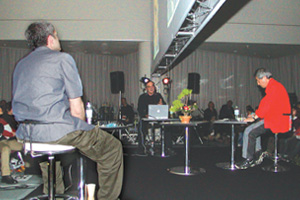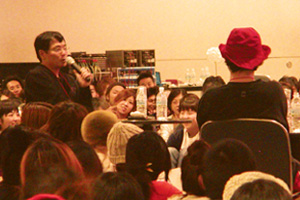|
|
 |
 |
 |
| Shigeo Fukuda
(Japan), Omar Vulpinari (Italy),Seymour Chwast(USA) |
 |
On (not) Getting the Knock-knock
Getting a joke is often the most difficult thing in a foreign culture:
to understand the humor that comes out of upending graphical, verbal
and societal norms requires understanding what is is expected in the
first place. Time and place, culture and context are everything. A view
into humor from an American, Italian, and Japanese designer included
culturally grounded plays on graphic conventions, pictorial codes and
verbal expectations. Shigeo Fukuda opened with a presentation describing
the migration of graphic ideas across cultures, showing the evolution
of historical graphic forms as they have been borrowed across cultures.
Seymour Chwast, an American with a history of sophisticated social and
political satire dating from the sixties to the present, employs an illustration-based
design quoting heavily from the graphic language of American cartoons.
Recent work Omar Vulpinari showed from students at Fabrica in Italy,
uses a graphical language based contemporary glossy magazines to communicate
wordlessly. While employing only images moves the work towards international
understanding, interpreting those images becomes even more bound in understanding
the context and culture in which they were produced. In one series, a
student took portraits of people on the street wearing masks they chose
from his collection. Each photo told a rich story that required knowing
the mask character and reading the occupation and social status of the
person through their surroundings. Mr. Fukuda ended the session with
a particularly Japanese inversion of expectations: He produced a bonsai
which shocked the audience. And then he proceeded to rip off the branches
and offer to the other lecturers, revealing that it was in fact a candy
plant. (GW)
|
 |
 |
 |
 |
 |
| Seiko Ito (Japan), Naohiro Ukawa (Japan) |
 |
Not knowing what to do
Wonder and shock together can produce comedy: in the space of confusion
over not knowing what will happen next because all of your cultural codes
have just been so thoroughly violated that you know longer have basis
on which to form any expectation, laughter spontaneously arises, taking
control of the body in a set of nearly autonomic responses that are as
hard to let go of as they are to induce. Like the uncontrollable laughter
at an embarrassing situation, it is not always comfortable and almost
always has a touch of the forbidden or naughty to it. This session opened
with a video about a comedic duo of dwarves from Brooklyn who have made
a career of upsetting expectations and cultural norms. In a series of
videos, they cause delivery men to bring things to their apartment, and
then greet them in the nude with bizarre behaviors, creating situations
designed to make the delivery men uncomfortable. As the men struggle
with how to handle the situation, the audience as well no longer knows
what to expect, suddenly all the rules are gone: the space for action
is wide open and suddenly we are doing what every comedian and every
graphic designer really want most desperately from their audience: we
are paying attention, holding our breath with anticipation about what
will happen next. Like in comedy, styles of interaction can become codified
quickly into stale techniques that no longer surprise or engage. Ito
and Ukawa reinforced their message about the power of impromptu interactions
by giving a talk-show style presentation, seated at tables in the center
of the room.(GW)
|
 |
 |
 |
Writer:Kosuke Ikehata/Norimitsu Korekata/Junko Sakamoto/Nobuko
Shimuta/Naoko Hasegawa/Osamu Hisanaga/Sakurako Muto/Naho Yoshioka/Helmut Langer/Maggie Hohle/Nicole Rechia/Trysh Wahlig/Gitte Waldman/Robert Zolna
Photographer:Yoshimitsu Asai/Yasuhiko Katsuta/Fumihiko Mizutani |
 |
|

